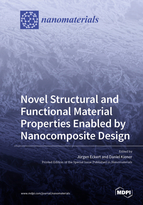Novel Structural and Functional Material Properties Enabled by Nanocomposite Design
A special issue of Nanomaterials (ISSN 2079-4991). This special issue belongs to the section "Nanocomposite Materials".
Deadline for manuscript submissions: closed (31 August 2021) | Viewed by 27894
Special Issue Editors
2. Department of Materials Science, Montanuniversität Leoben, Franz Josef-Straße, 18 A-8700 Leoben, Austria
Interests: nanostructured materials; metastable materials; functional and structural materials; materials for energy storage, conversion; materials for biomedical applications; bulk structures, particles, powders, thin films; physical and mechanical properties; structure-property correlations; composite structures; additive manufacturing techniques
Special Issue Information
Dear Colleagues,
Nanocomposites have the potential to enable material properties that exceed the capabilities of their individual constituent phases by far, thereby, enabling the exploration of white areas on material property charts. In this inaugural Special Issue for the newly released subsection Nanocomposites in the Journal Nanomaterials, we aim to provide an overview of the state of the art in enabling novel structural and functional material properties using nanocomposites. We welcome contributions regarding the synthesis, characterization, modeling, and in-depth understanding of the mechanisms governing the outstanding properties of this fascinating material class. Properties of interest encompass, but are not limited to, structural properties (e.g., strength, ductility, and high-temperature stability), functional properties (e.g., soft magnetic properties, energy storage, and radiation resistance), and property by design strategies (bioinspired design, topology optimization).
Prof. Dr. Jürgen Eckert
Assoc. Prof. Dr. Daniel Kiener
Guest Editors
Manuscript Submission Information
Manuscripts should be submitted online at www.mdpi.com by registering and logging in to this website. Once you are registered, click here to go to the submission form. Manuscripts can be submitted until the deadline. All submissions that pass pre-check are peer-reviewed. Accepted papers will be published continuously in the journal (as soon as accepted) and will be listed together on the special issue website. Research articles, review articles as well as short communications are invited. For planned papers, a title and short abstract (about 100 words) can be sent to the Editorial Office for announcement on this website.
Submitted manuscripts should not have been published previously, nor be under consideration for publication elsewhere (except conference proceedings papers). All manuscripts are thoroughly refereed through a single-blind peer-review process. A guide for authors and other relevant information for submission of manuscripts is available on the Instructions for Authors page. Nanomaterials is an international peer-reviewed open access semimonthly journal published by MDPI.
Please visit the Instructions for Authors page before submitting a manuscript. The Article Processing Charge (APC) for publication in this open access journal is 2900 CHF (Swiss Francs). Submitted papers should be well formatted and use good English. Authors may use MDPI's English editing service prior to publication or during author revisions.
Keywords
- Nanocomposites
- nanolaminates
- interface design
- strength-ductility tradeoff
- size effects








